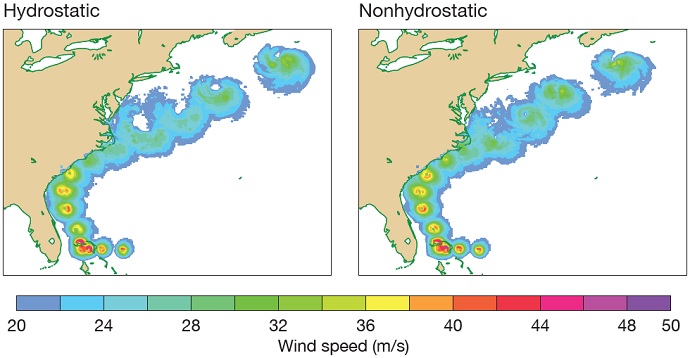

ECMWF has worked with experts in its Member States to test a new numerical scheme for calculations over the vertical grid in its Integrated Forecasting System (IFS). The results of initial tests are very promising.
“The scheme was originally developed for the limited-area modelling consortium ALADIN,” says Jozef Vivoda, the Head of Numerical Weather Prediction at the Slovak Hydrometeorological Institute (SHMI).
“However, it can work with any model that uses the same approach to atmospheric dynamics. This includes ECMWF’s global Integrated Forecasting System and some other European limited-area models.”
During a two-month visit to the Centre earlier this year, Jozef worked with ECMWF scientists to adapt the scheme to the requirements of the IFS.
Motivation
The IFS employs different numerical schemes to solve the equations describing atmospheric dynamics in the horizontal and in the vertical.

Numerical weather prediction covers the Earth in a grid and makes forecasts for each grid point. Those points are about 9 km apart in ECMWF’s highest-resolution forecasts (HRES). The grid also extends in the vertical, where the atmosphere is divided into 137 levels in HRES. Limited-area models use a finer grid over specific regions to enable more detailed forecasts for those regions.
The vertical scheme uses a finite-element discretisation method. It is known by the acronym VFE (vertical finite element) and was implemented in the IFS in 2002.
The VFE works very well with the vertical grid spacings currently used in the IFS, which range from tens of metres near the ground to several kilometres near the model top. But there are several reasons why ECMWF was looking to review the VFE:
- A new scheme might offer greater flexibility in the chosen accuracy in the vertical
- A new scheme might be better suited for reduced precision in calculations at the same level of accuracy, thus saving on computational cost
- A new scheme may be needed at future higher resolutions, at which the ‘hydrostatic assumption’ is no longer valid, i.e. the assumption that the decrease of pressure with height is balanced by the downward-directed gravitational pull of the Earth.
“Developing a new numerical scheme is difficult and time-consuming,” says ECMWF scientist Filip Váňa, who worked with Jozef on adapting the new scheme. “We were therefore keen to follow up on the work carried out in this field in the limited-area modelling community in our Member States.”
Successful collaboration
Jozef confirms that developing the new VFE for the limited-area modelling community was a major undertaking.
“We started to develop it more than ten years ago. I was the lead developer but have collaborated closely with Petra Smolíková from the Czech Hydrometeorological Institute (CHMI). We also collaborated with Spanish colleagues and visited Spain to drive the development of the scheme forward.”
Jozef’s objectives during his visit to ECMWF were, first, to implement the new VFE in the hydrostatic IFS, and second, to try to run the scheme in a nonhydrostatic version of the IFS.
“The benefit of using our scheme in the hydrostatic IFS is that it enables greater flexibility, with the potential for higher accuracy in the vertical,” he explains.
While the new VFE was originally developed to work with nonhydrostatic models, Jozef is pleased that he has been able to test it with the hydrostatic IFS. “This forced me to review some basic choices I had made in the nonhydrostatic case,” he says.
Filip agrees that this was a very successful visit for both sides. “A global model is an excellent tool for numerical scheme development as it offers much better control compared to limited-area models. From this point of view, the visit was also beneficial to the limited-area community.”
Outcomes
During Jozef’s visit, it was shown that the new scheme offers several benefits for the IFS at the same computational cost: higher accuracy in the vertical discretisation; smaller sensitivity to the model’s vertical resolution and numerical precision; and the ability to use the same vertical discretisation in the modelling of hydrostatic and nonhydrostatic dynamics.
To test the latter aspect, ECMWF recently ran a 10-day forecast at a grid spacing of 5 km with the new nonhydrostatic VFE for Hurricane Dorian, which struck the Bahamas in September 2019, and compared it with the equivalent hydrostatic forecast using the new VFE.

The charts show maximum 10 m wind speed for a 10-day forecast of Hurricane Dorian, starting from 12 UTC on 31 August 2019, at a grid spacing of 5 km, for every 12 hours starting 12 hours into the forecast. The left-hand panel shows the forecast using the hydrostatic IFS with the new VFE and the right-hand panel the forecast using the nonhydrostatic IFS with the new VFE. Both forecasts were run in single precision, using the same time step of 240 s and, where applicable, identical settings for model dynamics.
“As the figure shows, the forecasts are remarkably similar up to day 5 and produce similar results even at forecast ranges beyond that,” says Michail Diamantakis, the Head of the Numerical Methods Group at ECMWF. “They also agree very well with the observed hurricane track, indeed better than ECMWF’s operational high-resolution forecast.”
Based on very encouraging results in first tests, it is anticipated that the new VFE will replace the existing scheme once it has been extended to and carefully tested for all configurations used at ECMWF.
